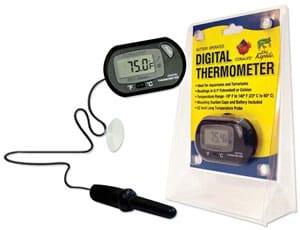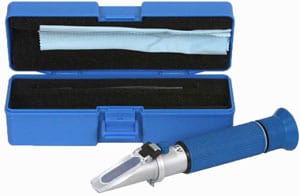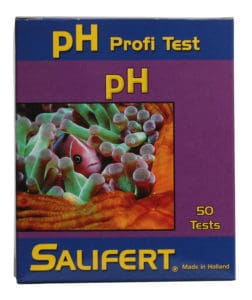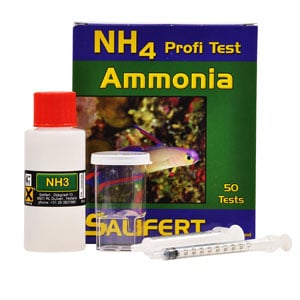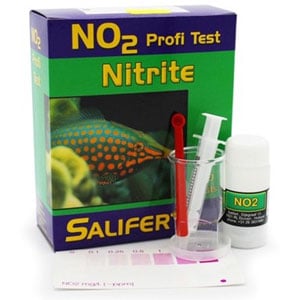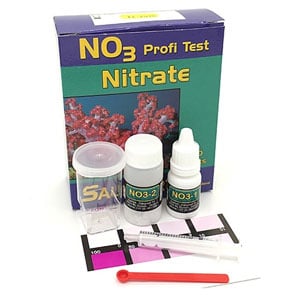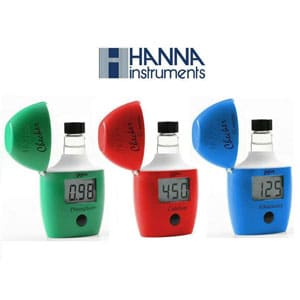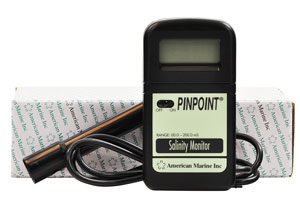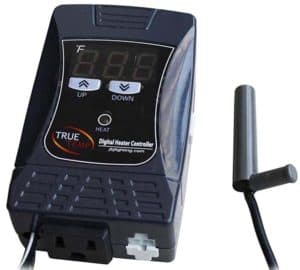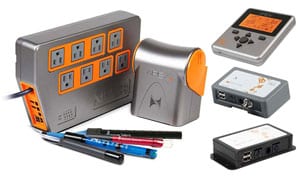When I used to keep freshwater aquariums I never tested my water, heck I just used water from the tap! A water change once a month or when the algae got bad and that was about it. Sound familiar? Boy was I in for a learning curve when I decided to make the jump to saltwater!
To many, the idea of testing can conjure up thoughts of hours spent dripping fluids into test tubes and not really fully understanding why. When you move to saltwater aquariums your goal is not to keep livestock but to instead keep water. If you can keep your water exactly where it needs to be then the rest follows pretty well.
The Main Water Parameters To Test In A Saltwater Aquarium Are:
- Temperature: 78 – 80°F or 25 – 27°C
- Specific Gravity (Salinity): 1.023 – 1.025
- Ph: 8.1 – 8.4
- Ammonia: 0ppm
- Nitrite: 0ppm
- Nitrate: <5ppm
- Alkalinity: 8 – 12 dkh
- Calcium: 350 – 450ppm
- Magnesium: 1250 – 1350ppm
- Phosphate: <0.03ppm for SPS Corals
- Phosphate: <0.05ppm for LPS, Zoas & Soft Corals
- Phosphate: <0.2ppm for Fish Only
During the first few months of the life of your new reef aquarium, testing some of these water parameters are going to become very routine. Below are the exact products and schedule I use every week to monitor my water and keep it as stable as I can.
What Needs To Be Tested & Why In A Saltwater Aquarium?
After installing all your equipment and filling your aquarium with water the first process your new aquarium is going to be faced with is its ‘Cycle’, also known as the Nitrogen Cycle.
The Nitrogen Cycle is the process that begins cultivating the beneficial nitrifying bacteria within your aquarium. The job of the bacteria is to convert the toxins released by waste and detritus (Link To Glossary) and turn them into less harmful compounds that can be tolerated by your livestock.
The only way to know where your aquarium is during this process is by testing the water every day or so and monitoring the results.
Let’s take a look at each of the parameters and see why you need to test them:
Temperature:
Reading: 78°F-80°F or 25°C-27°C
For a Tropical Saltwater Aquarium, you need to maintain a water temperature of around 78°F – 80°F or 25°C – 27°C. Your heater will do this automatically but the ambient temperature of the room containing the aquarium can cause the water to increase in heat if you live in a hot location.
The heater will be shut off but the air may continue to warm your tank. This is something you need to monitor to see if the home AC needs to be increased or an aquarium chiller is needed.
For more information on Aquarium Chillers you can read my article:
What Size Chiller Do I Need For My Aquarium?
The main reason you want to get your heater set now is that it will take a few days for you to fine-tune the adjustment to keep your water within this range.
Your bacteria will need this temperature to grow at the most efficient rate and the cycle time will allow you to monitor your heater to make sure it maintains the correct temperature before you add any livestock – Only add livestock AFTER the cycle is complete!
Most owners will have a simple digital temperature monitor to keep an eye on their water temp:
You can find a simple thermometer like this HERE at Amazon.com
They work really well when stuck on the side of the aquarium to give you an instant reading as you walk past.
Also, get in the habit of touching the glass each time you pass. You will soon learn what it feels like and it will instantly tell you if the temperature is not right – This saved my tank once!
Salinity:
Reading: 1.023-1.025 SG
The salinity is how much salt is dissolved in the water. When you mix your first batch of water to fill the aquarium and when you mix water for regular water changes you want to try and keep the salinity range of 1.023 – 1.025 SG (Specific Gravity). This is the ratio of salt molecules to water molecules and you need to try and keep this as stable as possible.
This will be new to you if you are coming from freshwater and now you need to be aware of evaporation of the water. Because the aquarium water temperature is around 80°F, the water will evaporate into the atmosphere, and this can be in the range of gallons of water each day for a large aquarium!
Salt does not evaporate, so as your water evaporates it leaves the salt molecules behind and alters the ratio.
The more water evaporates = The saltier the remaining water will become
To combat this you need to replace the evaporated water with FRESHWATER ONLY to bring the ratio back in line. Most aquarists install a simple device called an Automatic Top-Off System to take care of this function.
For more information on Automatic Top-Off Systems you can read my article:
What Is An Aquarium Auto Top Off?
Pretty much every experienced aquarium owner will test their salinity level with a refractometer at the very least. Stay away from Hydrometers, they are incredibly inaccurate!
You can get a very reliable and accurate refractometer like this Here at Amazon.com
They are simple to use, easy to calibrate regularly, and are very accurate. This should be one of the first testing items you buy! You will use it every week for the life of the aquarium!
For more information on how to easily test your salinity you can read my article:
How To Measure Salinity In An Aquarium
Ph:
Reading: 8.1-8.4
Ph is the acidity of the water. The Ph range goes from 1 to 14 with 7 being neutral. Below 7 the water gets more acidic and above 7 the water becomes more alkaline. The range you want to be keeping your aquarium in is around 8.1 – 8.4 with natural seawater being at 8.2.
Ph is important to keep stable as it can stress livestock if it becomes too far out of range and corals use the Ph to help build their skeletons. Ph will fluctuate throughout the day because it is affected by carbon dioxide.
There are two main ways that carbon dioxide will lower the Ph which you need to be aware of:
- At night your Ph will drop due to algae and plant-based material not photosynthesizing and consuming carbon dioxide. This can be offset by installing a Refugium and running the light during the opposite hours to your display tank.
- If your home is well sealed because of home Air-Con or Northern Winters the level of carbon dioxide will begin to build in the home. This will also cause your Ph to drop over time until your home is ‘Aired Out’.
For more information on Refugiums you can read my article:
What Is A Refugium?
Ph is a simple parameter to test for and by testing for it at the same time of the day you will begin to get an understanding if your Ph is gradually reducing.
The Salifert Test Kits are the only kits I use and you can get this Here at Amazon.com
I test my Ph every week on a Tuesday evening. You will want to test more often during the cycle so you begin to understand how your water fluctuates each day/week/month.
Ammonia:
Reading: Zero ppm
Ammonia is a byproduct of waste and debris as they break down and decay. As your fish go to the bathroom, as the uneaten food lies buried in a crevice, as algae die off they will all begin to rot, this rotting releases ammonia into your water.
Ammonia is highly toxic to your livestock and even very low levels can begin to harm them.
Ammonia is converted to less harmful Nitrites by the beneficial bacteria in your aquarium during the ongoing Nitrogen Cycle. However, the initial cycle of the aquarium will have levels of ammonia off the charts, hence why you should never cycle an aquarium using fish!
During the aquarium’s initial cycle, ammonia is the first parameter you will need to test for.
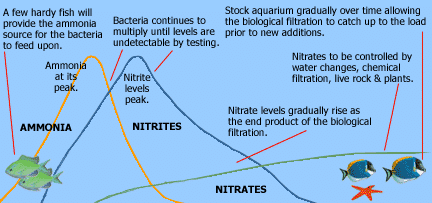
Just As Ph, the Salifert Test Kits are the only kits I use and you can get this Here at Amazon.com
During the initial cycle, you will need to test for ammonia every day until it has dropped to zero.
After that, I only test for ammonia once a month, if I suspect a problem or when my fish are in Quarantine.
Nitrite:
Reading: Zero ppm
The second stage of the nitrogen cycle you will test for. As the Nitrosomonas Bacteria begin to consume ammonia they turn it into the less toxic, but still harmful Nitrite.
As you can see on the chart, as the Nitrosomonas Bacteria begin to grow and multiply the ammonia will be consumed at a greater rate and the ammonia levels will begin to drop. As the ammonia drops the Nitrite level will increase.
Do you want to know more about the Nitrogen Cycle? Try my article:
How Do You Know When Your Fish Tank Is Cycled?
You can find the Nitrite test kit Here at Amazon.com
As you begin to see your ammonia level drop you will need to begin testing for nitrite every day to follow that peak of the cycle.
After Nitrite has dropped to zero you should never really need to test for it again.
Nitrate:
Reading: 0-5ppm
The last spike in the Nitrogen Cycle you will be wanting to monitor. At this point, you will start to get excited as your aquarium cycle is on the final stretch. It won’t be too much longer until you can add your first fish!
As mentioned, the nitrite compounds are still harmful to aquatic livestock so mother nature has developed another bacteria to deal with them! Nitrobacter Bacteria will be to grow in your aquarium as the nitrites begin to grow. This strain of bacteria feeds on the nitrite and converts them to tolerable nitrate.
Nitrate is far less harmful to livestock and they can tolerate much higher levels of it. Nitrate is a parameter that you will test for throughout the life of your aquarium and keeping it low will be one of your main goals as an aquarist.
You can find the Nitrate test kit Here At Amazon.com
Nitrates will gradually build as your nitrite becomes consumed. These levels will not spike like ammonia and nitrite, but gradually increase over time.
You will want to try and keep nitrate less than 5ppm especially when you begin adding coral. Fish-Only will tolerate up to 20ppm.
How Often Do you Need To Test Aquarium Water?
During the initial cycle of your aquarium you will need to be testing as follows:
| Temperature | Daily |
| Salinity | Daily |
| Ph | Every 1-2 Days |
| Ammonia | Every 1-2 Days |
| Nitrite | Every 1-2 Days |
| Nitrate | Every 1-2 Days |
Once your initial cycle has completed you will want to set up the following testing routine to establish good habits and allow for easy detection of problems while you learn your aquarium:
| Temperature | Daily |
| Salinity | Weekly |
| Ph | Weekly |
| Ammonia | Weekly |
| Nitrite | Never – Unless Suspected |
| Nitrate | Weekly |
To help you summarize what your parameters should be throughout the life of your aquarium you can aim for these ideal water parameters:
- Temperature: 78 – 80°F or 25 – 27°C
- Specific Gravity (Salinity): 1.023 – 1.025
- Ph: 8.1 – 8.4
- Ammonia: 0ppm
- Nitrite: 0ppm
- Nitrate: <5ppm
- Alkalinity: 8 – 12 dkh
- Calcium: 350 – 450ppm
- Magnesium: 1250 – 1350ppm
- Phosphate: <0.03ppm for SPS Corals
- Phosphate: <0.05ppm for LPS, Zoas & Soft Corals
- Phosphate: <0.2ppm for Fish Only
The parameters you see on the second part of the list will be things you will want to monitor further into the life of your aquarium and they are more applicable to keeping coral. As a beginner do not be too concerned about these additional parameters, just be aware of them for when you reach the point of keeping LPS and SPS corals (Link to Glossary).

Not sure what maintenance you should be doing each week or even what equipment you may need to set up your tank?
Click HERE to get hold of my Super Helpful FREE Set of Guides & other helpful resources to help you breeze through your first few months of a new reef tank with ease?
Are There Any Advanced Aquarium Water Testing Equipment?
Testing is an important part of maintaining your aquarium but sometimes the testing can get difficult if you are colorblind, have a hard time differentiating between similar color shades or are even away from home a lot. Luckily we have some great technology in this hobby that can give you options and even automate some of the tests you will need to do.
Below is a brief list of some of the best pieces of equipment that can make your life so much simpler. Each is linked to its associated product page on Amazon.com so you can get even further information, reviews, and prices.
Hanna Checkers
These great little devices take out the color-matching aspect of most test kits. Take a sample of water, add the agent liquid to it, place it in the checker and the result is displayed on a screen! Simple!
They come in a range of parameters.
Find them Here at Amazon.com
Pinpoint Monitors
American Marine makes some superb digital testing devices for not only the aquarium hobby but the whole scientific/laboratory industries.
Their simple probes and digital readouts make them great for quick, instant testing or constant monitoring and control.
They have a range of devices to just test, or monitor and control.
Find them Here at Amazon.com
Temperature Controllers
Most aquarium heaters have internal temperature controllers but every now and then they can malfunction and not work or stick on and cook your aquarium.
To combat the aquarium being cooked a simple temperature controller will monitor the water temperature and cut power to the heater if the water gets too hot.
The other benefit of this control is they can be calibrated and they give an instant digital readout of the current temperature.
Find them Here at Amazon.com
Aquarium Controllers
The ultimate gadget for monitoring and control. Aquarium controllers are one of the best but most expensive additions to any saltwater aquarium, but they can be worth it.
Many controllers come with a variety of sensors to monitor several parameters along with dozens and dozens of functions to automate and control your tank.
I will never own an aquarium without one but they will cost you.
If you wish to find out more about these please check out my dedicated article on them:

